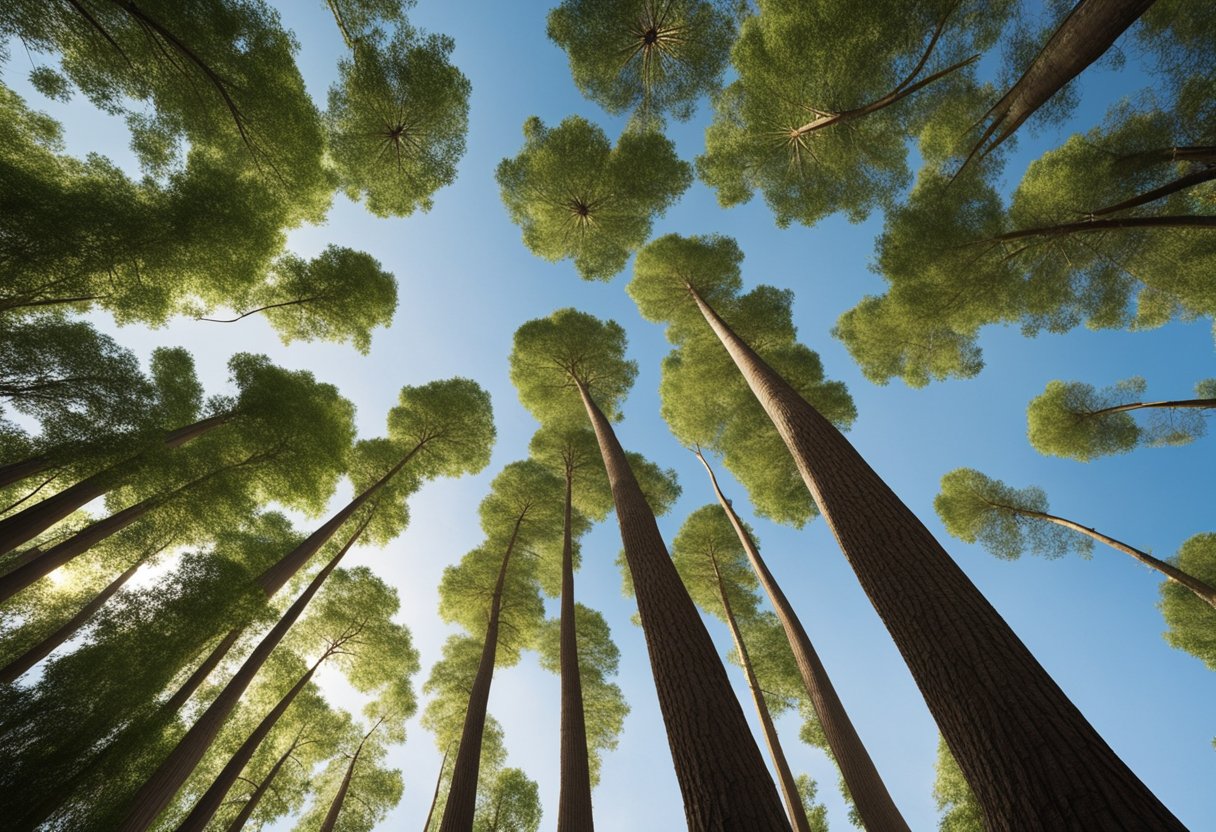Tall, skinny columnar trees are a great addition to any landscape, adding vertical interest and structure without taking up too much space. These trees are perfect for narrow spaces, creating screens for privacy, or framing entrances and pathways. With so many species to choose from, it can be overwhelming to decide which one is right for your specific needs. In this article, I will highlight 11 of the best tall skinny columnar trees, their characteristics, and how to plant and maintain them.

Characteristics of Tall Skinny Columnar Trees vary from species to species. Some are deciduous, while others are evergreen. Some produce beautiful flowers in the spring, while others have stunning foliage in the fall. They all have a narrow, upright growth habit, making them perfect for tight spaces. Popular species include the Italian Cypress, the Skyrocket Juniper, and the Emerald Green Arborvitae.
When selecting a tall skinny columnar tree, it’s important to consider its climatic requirements, landscaping uses, and maintenance needs. Some trees are more drought-tolerant than others, while some require more pruning. It’s also important to consider the tree’s ultimate height and width, as well as its growth rate. With proper selection, planting, and maintenance, tall skinny columnar trees can provide many environmental benefits and enhance the beauty of any landscape.
Key Takeaways
- Tall skinny columnar trees are perfect for narrow spaces and adding vertical interest to a landscape.
- Popular species include the Italian Cypress, the Skyrocket Juniper, and the Emerald Green Arborvitae.
- When selecting a tree, consider its climatic requirements, landscaping uses, and maintenance needs.
Characteristics of Tall Skinny Columnar Trees

As a lover of trees, I find tall skinny columnar trees to be particularly fascinating. They are known for their unique shape, which is tall and slender, making them perfect for small gardens or tight spaces. Here are some characteristics of tall skinny columnar trees:
- Height: As the name suggests, tall skinny columnar trees are known for their height. They can grow up to 70 feet tall, making them an excellent choice for those who want to add some vertical interest to their garden.
- Shape: Unlike traditional trees that can spread out wide, columnar trees grow tall and slim. They have a narrow, upright shape, which makes them ideal for lining driveways, walkways, or even as a privacy screen between neighboring properties.
- Leaves: Columnar trees have a variety of leaves, depending on the species. Some have needle-like leaves, while others have broad, flat leaves. The leaves can be evergreen or deciduous, depending on the species.
- Growth Rate: Tall skinny columnar trees tend to grow at a slower rate than other types of trees. This can be an advantage for those who want a low-maintenance tree that won’t require constant pruning or care.
- Maintenance: While columnar trees require less maintenance than other trees, they still need some care to keep them healthy. This includes regular watering, fertilizing, and pruning.
Some popular species of tall skinny columnar trees include Italian Cypress, Skyrocket Juniper, Emerald Green Arborvitae, and Columnar Oak. Each of these species has its own unique characteristics, but they all share the tall, slender shape that makes them so appealing.
Popular Species

If you’re looking for tall, skinny columnar trees, there are several popular species that you might want to consider. Here are a few of the most common options:
Italian Cypress
Italian Cypress (Cupressus sempervirens) is a popular choice for those looking for tall, skinny columnar trees. These trees can grow up to 60 feet tall, but usually stay much narrower than they are tall. They have a very distinctive look, with upright branches covered in dark green foliage. Italian Cypress trees are also very drought-tolerant, making them a great choice for areas with hot, dry summers.
Emerald Green Arborvitae
Emerald Green Arborvitae (Thuja occidentalis ‘Smaragd’) is another popular choice for tall, skinny columnar trees. These trees can grow up to 15 feet tall, but usually stay narrower than they are tall. They have a very dense, compact growth habit, with bright green foliage that stays green all year round. Emerald Green Arborvitae trees are also very low-maintenance, making them a great choice for those who want a beautiful tree without a lot of work.
Sky Pencil Holly
Sky Pencil Holly (Ilex crenata ‘Sky Pencil’) is a great choice for those who want a tall, skinny columnar tree with a bit of color. These trees can grow up to 10 feet tall, but usually stay much narrower than they are tall. They have a very distinctive look, with upright branches covered in dark green foliage and small, white flowers in the spring. Sky Pencil Holly trees are also very low-maintenance, making them a great choice for those who want a beautiful tree without a lot of work.
There are many great options for tall, skinny columnar trees. Whether you prefer the look of Italian Cypress, the low-maintenance nature of Emerald Green Arborvitae, or the colorful foliage of Sky Pencil Holly, there’s sure to be a tree that’s perfect for your needs.
Climatic Requirements
Sunlight Exposure
As a general rule, tall skinny columnar trees require full sun exposure to grow to their full height and maintain their narrow shape. They need at least six hours of direct sunlight per day to thrive. However, some species can tolerate partial shade, especially in hot climates where full sun exposure can be too intense. It is important to check the specific sunlight requirements of each tree species before planting to ensure they are suitable for your garden’s conditions.
Soil Preferences
Tall skinny columnar trees thrive in well-draining soils that are rich in nutrients. They prefer slightly acidic to neutral soils with a pH range of 6.0 to 7.5. It is important to avoid planting them in soils that are too compact or waterlogged, as this can lead to root rot and other diseases. Adding organic matter such as compost or peat moss to the soil can improve its drainage and nutrient content, making it more suitable for growing these trees.
Watering Needs
Tall skinny columnar trees have moderate to high watering needs, especially during the first few years after planting. They require regular watering to establish their roots and maintain their growth. However, overwatering can be harmful, as it can lead to root rot and other diseases. It is important to water these trees deeply but infrequently, allowing the soil to dry out slightly between waterings. Mulching around the base of the tree can help retain moisture and regulate soil temperature, promoting healthy growth.
Landscaping Uses

When it comes to landscaping, tall skinny columnar trees can serve a variety of purposes. Here are a few ways to use them in your yard:
Privacy Screens
One of the most popular uses for tall skinny columnar trees is to create privacy screens. These trees can be planted close together to form a dense barrier that blocks out unwanted views from neighbors or passersby. Some great options for privacy screens include Leyland Cypress, Emerald Green Arborvitae, and Sky Tower Ginkgo.
Accent Features
Tall skinny columnar trees can also be used as accent features in your landscaping design. These trees can help to draw the eye upward and create a sense of verticality in your yard. Some great options for accent features include Columnar Ginkgo, Crimson Pointe Purple Leaf Plum, and Armstrong Gold Maple.
Windbreaks
Finally, tall skinny columnar trees can also be used as windbreaks. These trees can help to protect your yard from strong winds, which can be especially important if you live in an area that experiences frequent storms. Some great options for windbreaks include Malonyana Arborvitae, Beacon Swamp White Oak, and DannaSpire Columnar Elm.
Tall skinny columnar trees are a versatile and attractive addition to any landscaping design. Whether you’re looking to create privacy, add visual interest, or protect your yard from the elements, there’s a tree out there that’s perfect for your needs.
Planting Guidelines
When it comes to planting tall skinny columnar trees, there are a few guidelines to keep in mind to ensure that they grow healthy and strong. Here are some important considerations to keep in mind:
Spacing
One of the most important factors to consider when planting tall skinny columnar trees is spacing. These trees need enough room to grow and spread out, but they also need to be planted close enough together to create the desired effect. As a general rule, you should plant columnar trees about 10-15 feet apart. This will give them enough room to grow while still creating a dense, vertical screen.
Depth and Positioning
Another important factor to consider when planting tall skinny columnar trees is depth and positioning. You’ll want to dig a hole that’s deep enough to accommodate the tree’s roots, but not so deep that the tree will be planted too low in the ground. As a general rule, you should dig a hole that’s about twice as wide as the tree’s root ball and just deep enough so that the top of the root ball is level with the ground.
When positioning your tree, make sure that it’s planted in a spot that gets plenty of sunlight and has well-draining soil. You’ll also want to make sure that the tree is planted in an area that’s protected from strong winds, as tall skinny columnar trees can be more susceptible to damage from wind than other types of trees.
Support and Staking
Finally, it’s important to provide support and staking for your tall skinny columnar trees. These trees can be top-heavy and may require additional support to keep them upright and stable. You can use stakes or other support structures to help keep your trees in place while they establish their roots.
When staking your trees, be sure to use materials that won’t damage the bark or trunk of the tree. You’ll also want to make sure that the stakes are driven deep enough into the ground to provide adequate support. As a general rule, stakes should be driven into the ground at a 45-degree angle, with the top of the stake pointing away from the tree.
Maintenance Tips

As a tree owner, it is important to maintain your tall, skinny columnar trees to ensure their longevity and health. Here are some tips on how to properly maintain your trees:
Pruning
Regular pruning is essential to maintain the shape and size of your columnar trees. It is recommended to prune your trees in late winter or early spring before new growth appears. Prune any dead, damaged, or diseased branches to prevent them from spreading to the rest of the tree. Additionally, thin out any overcrowded branches to improve air circulation and sunlight penetration.
Fertilizing
Fertilizing your trees can help improve their overall health and growth. Apply a balanced fertilizer in early spring before new growth appears. Be sure to follow the manufacturer’s instructions on the amount and frequency of application. Avoid over-fertilizing as this can lead to excessive growth and weak branches.
Pest and Disease Management
Tall, skinny columnar trees are susceptible to a variety of pests and diseases. Regularly inspect your trees for any signs of infestation or disease, such as holes in the leaves, discoloration, or wilting. Treat any issues promptly to prevent them from spreading to the rest of the tree or other nearby trees. Consider using organic or natural pest and disease control methods to avoid the use of harmful chemicals.
By following these maintenance tips, you can ensure the health and longevity of your tall, skinny columnar trees. Regular pruning, fertilizing, and pest and disease management can help keep your trees looking beautiful and healthy for years to come.
Also Read | 9 Plants That Don’t Need Drainage Holes: A Guide to Low-Maintenance Houseplants
Growth and Development

Growth Rate
When selecting a tall skinny columnar tree, it is important to consider its growth rate. Some species grow faster than others, while some take longer to mature. The growth rate of a tree can be influenced by various factors such as soil type, moisture, and temperature.
Mature Height
The mature height of a tree is another important consideration when choosing a tall skinny columnar tree. Some species can grow up to 60 feet tall, while others only reach 20 feet. It is important to choose a tree that will fit the space available and not outgrow its surroundings.
Lifespan
The lifespan of a tree can vary greatly depending on the species. Some trees can live for hundreds of years, while others only live for a few decades. It is important to choose a tree with a lifespan that fits your needs and expectations.
11 Tall Skinny Columnar Trees
Here are 11 tall skinny columnar trees with varying growth rates, mature heights, and lifespans:
- Italian Cypress (Cupressus sempervirens): This fast-growing evergreen tree can reach up to 60 feet tall and has a lifespan of up to 150 years.
- Emerald Green Arborvitae (Thuja occidentalis ‘Smaragd’): This slow-growing evergreen tree can reach up to 15 feet tall and has a lifespan of up to 50 years.
- Columnar Blue Spruce (Picea pungens ‘Fastigiata’): This slow-growing evergreen tree can reach up to 30 feet tall and has a lifespan of up to 600 years.
- Skyrocket Juniper (Juniperus scopulorum ‘Skyrocket’): This fast-growing evergreen tree can reach up to 20 feet tall and has a lifespan of up to 70 years.
- Swedish Columnar Aspen (Populus tremula ‘Erecta’): This deciduous tree can reach up to 40 feet tall and has a lifespan of up to 50 years.
- Columnar Hornbeam (Carpinus betulus ‘Fastigiata’): This deciduous tree can reach up to 40 feet tall and has a lifespan of up to 150 years.
- Columnar English Oak (Quercus robur ‘Fastigiata’): This deciduous tree can reach up to 60 feet tall and has a lifespan of up to 1,000 years.
- Columnar Sweetgum (Liquidambar styraciflua ‘Slender Silhouette’): This deciduous tree can reach up to 50 feet tall and has a lifespan of up to 75 years.
- Columnar Norway Maple (Acer platanoides ‘Columnare’): This deciduous tree can reach up to 50 feet tall and has a lifespan of up to 150 years.
- Columnar Redbud (Cercis canadensis ‘Covey’): This deciduous tree can reach up to 25 feet tall and has a lifespan of up to 50 years.
- Columnar Japanese Maple (Acer palmatum ‘Senkaki’): This slow-growing deciduous tree can reach up to 20 feet tall and has a lifespan of up to 100 years.
Environmental Benefits

As an arborist, I am always looking for ways to promote the benefits of trees. Columnar trees, in particular, offer a range of environmental benefits that make them a great addition to any landscape. Here are some of the most notable benefits:
Biodiversity Support
Columnar trees can provide habitat for a wide range of wildlife, including birds, insects, and small mammals. Even in urban environments, these trees can support biodiversity by providing a vertical structure that can be used for nesting, roosting, and foraging. By planting columnar trees, we can help create more diverse and resilient ecosystems.
Carbon Sequestration
Trees are known for their ability to absorb carbon dioxide from the atmosphere and store it in their tissues. Columnar trees are particularly effective at this, as their tall, narrow shape allows them to capture more sunlight and grow more quickly than wider trees. This means that they can sequester more carbon over a shorter period of time. By planting columnar trees, we can help mitigate the effects of climate change.
Shade and Cooling
Columnar trees can also provide shade and cooling benefits, which can help reduce energy costs and improve comfort in outdoor spaces. By blocking the sun’s rays, these trees can reduce the amount of heat that is absorbed by buildings and pavement. This can help mitigate the urban heat island effect, which can make cities feel much hotter than surrounding areas. Additionally, the shade provided by columnar trees can create more comfortable outdoor spaces for people to enjoy.
Columnar trees offer a range of environmental benefits that make them a great choice for any landscape. They can support biodiversity, sequester carbon, and provide shade and cooling benefits. By planting these trees, we can help create more sustainable, resilient, and livable communities.
Selection Considerations

When selecting tall, skinny columnar trees, there are several factors to consider to ensure that the trees thrive in your landscape. Below are some of the key considerations to keep in mind:
Hardiness Zone Suitability
The hardiness zone of your area is an important consideration when selecting trees. It is important to choose trees that are suitable for your climate to ensure that they can survive and thrive in your landscape. For example, if you live in a cold climate, you may want to choose trees that are hardy to your zone. Conversely, if you live in a warm climate, you may want to choose trees that can tolerate heat and drought.
Space Constraints
When selecting tall, skinny columnar trees, space constraints are an important consideration. It is important to choose trees that will fit within the space you have available. For example, if you have a narrow space, you may want to choose trees that have a narrow profile. Conversely, if you have a larger space, you may want to choose trees that have a wider profile.
Local Regulations
Local regulations are an important consideration when selecting tall, skinny columnar trees. It is important to check with your local government to ensure that the trees you choose are permitted in your area. Some cities and towns have regulations regarding the types of trees that can be planted, the size of trees that can be planted, and the distance trees must be planted from property lines and buildings. It is important to be aware of these regulations to avoid any potential issues down the road.
By considering these factors when selecting tall, skinny columnar trees, you can ensure that you choose trees that will thrive in your landscape and comply with local regulations.
Companion Planting

When it comes to planting columnar trees, companion planting can be a great way to enhance the beauty of your garden. Here are some tips for companion planting with tall skinny columnar trees.
Understory Combinations
Understory plants are those that grow beneath the canopy of larger trees. When planting columnar trees, it’s important to choose understory plants that can thrive in the shade and complement the look of the tree. Some good options include:
- Hostas
- Ferns
- Heucheras
- Bleeding hearts
- Coral bells
These plants can add texture and color to your garden while also providing a nice contrast to the tall, skinny columnar trees.
Complementary Species
In addition to understory plants, it’s also important to choose complementary species that can grow alongside your columnar trees. Some good options include:
- Flowering shrubs such as hydrangeas, azaleas, and rhododendrons
- Perennials such as coneflowers, black-eyed Susans, and daylilies
- Ornamental grasses such as feather reed grass, maiden grass, and little bluestem
These plants can add variety and interest to your garden while also complementing the look of your columnar trees.
When choosing companion plants for your columnar trees, it’s important to consider the growing conditions of each plant. Make sure to choose plants that have similar soil and light requirements to ensure that they can thrive together. With the right combination of plants, you can create a beautiful and cohesive garden that showcases the beauty of your tall skinny columnar trees.
Tree Preservation and Care

As a tree enthusiast, I understand the importance of preserving and caring for trees. Tall skinny columnar trees, in particular, require specific maintenance to ensure their longevity and health.
Here are some tips for preserving and caring for your tall skinny columnar trees:
Soil
The soil is the foundation of any tree’s health. Ensure that the soil is well-drained and rich in nutrients. Testing the soil can help you determine if it is lacking in any essential nutrients. If necessary, add organic matter, such as compost, to the soil to improve its quality.
Watering
Watering is critical for the survival of any tree. Ensure that you water your tall skinny columnar trees deeply and regularly. Avoid overwatering, as this can lead to root rot. The frequency of watering depends on the climate, soil, and tree species.
Pruning
Pruning is essential for the health and aesthetic appeal of your tall skinny columnar trees. Regular pruning can help remove dead or diseased branches, improve air circulation, and shape the tree. Prune your trees during the dormant season to avoid damaging the tree.
Pest Control
Pests can cause significant damage to your tall skinny columnar trees. Regular inspection can help you identify any pests early on. Use organic pest control methods whenever possible to avoid harming the environment.
Fertilization
Fertilization can help improve the growth and health of your tall skinny columnar trees. Use slow-release fertilizers to avoid over-fertilization, which can harm the tree. Fertilize your trees during the growing season to ensure maximum absorption.
By following these tips, you can ensure the longevity and health of your tall skinny columnar trees.
FAQs – 11 Tall Skinny Columnar Trees
What are the best fast-growing tall, narrow trees for privacy screens?
If you’re looking for fast-growing tall and narrow trees to create a privacy screen, you might consider Leyland Cypress, Thuja Green Giant, or Emerald Green Arborvitae. These trees are evergreen and can grow up to 30 feet tall with a width of only 4 to 6 feet.

Which tall and slender evergreen trees are suitable for narrow spaces?
If you have a narrow space and want to plant tall and slender evergreen trees, you might consider Skyrocket Juniper, Italian Cypress, or Columnar Blue Spruce. These trees are narrow and tall and can grow up to 20 to 30 feet tall with a width of only 2 to 3 feet.
What are some popular dwarf columnar tree varieties for small gardens?
If you’re looking for dwarf columnar trees for small gardens, you might consider Dwarf Alberta Spruce, Dwarf Hinoki Cypress, or Dwarf Blue Atlas Cedar. These trees are slow-growing and can grow up to 6 to 10 feet tall with a width of only 2 to 4 feet.
Can you recommend some deciduous trees with a columnar habit for landscaping?
If you want to add some deciduous trees with a columnar habit to your landscape, you might consider Fastigiate Hornbeam, Columnar English Oak, or Columnar Sugar Maple. These trees can grow up to 20 to 30 feet tall with a width of only 10 to 15 feet.
How can I use tall, skinny trees to enhance my fence line without taking up too much space?
If you want to enhance your fence line with tall and skinny trees without taking up too much space, you might consider planting them in a row along the fence. Some suitable trees for this purpose might include Sky Pencil Holly, Hicks Yew, or Columnar White Pine.
What species of pine trees maintain a tall and narrow form suitable for urban gardens?
If you’re looking for pine trees that maintain a tall and narrow form suitable for urban gardens, you might consider Columnar Scots Pine, Columnar Austrian Pine, or Columnar Japanese Black Pine. These trees can grow up to 20 to 30 feet tall with a width of only 4 to 6 feet.
